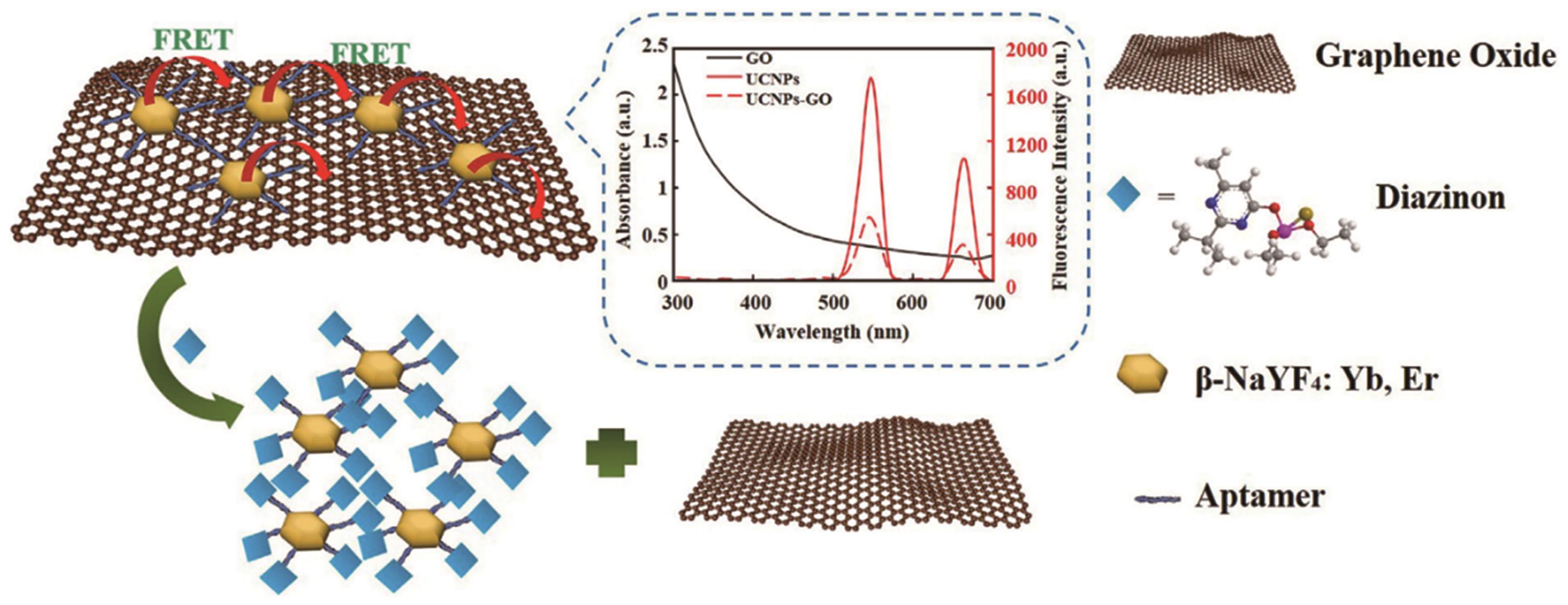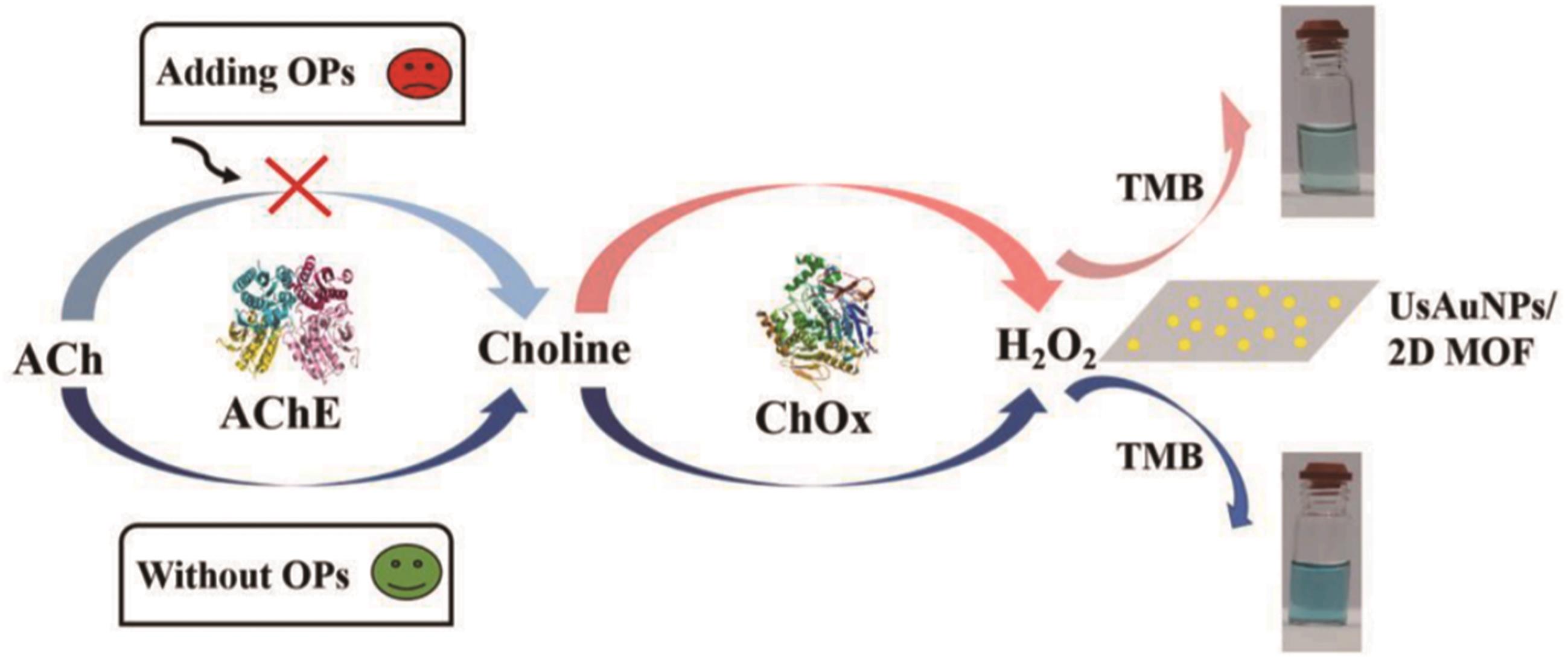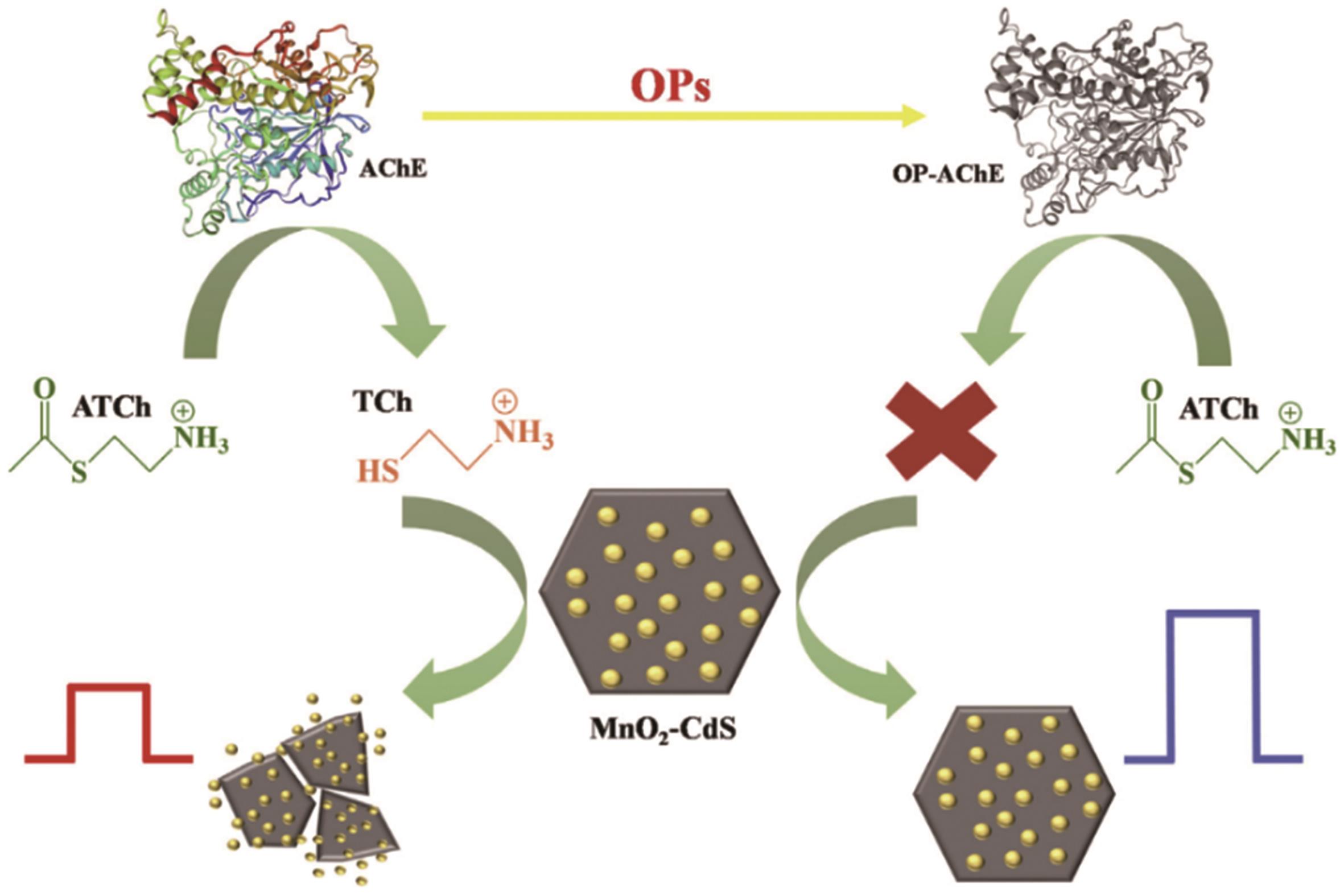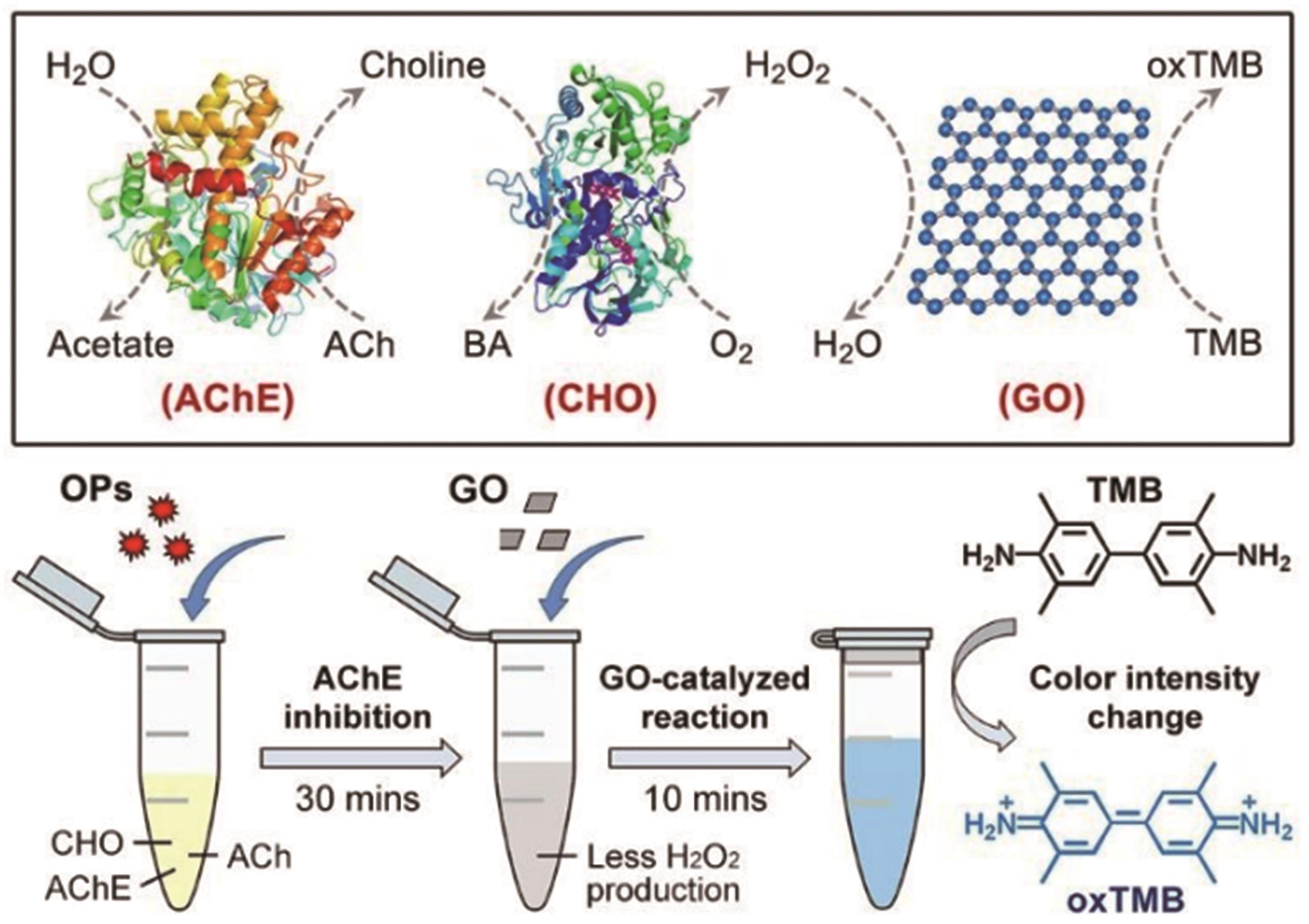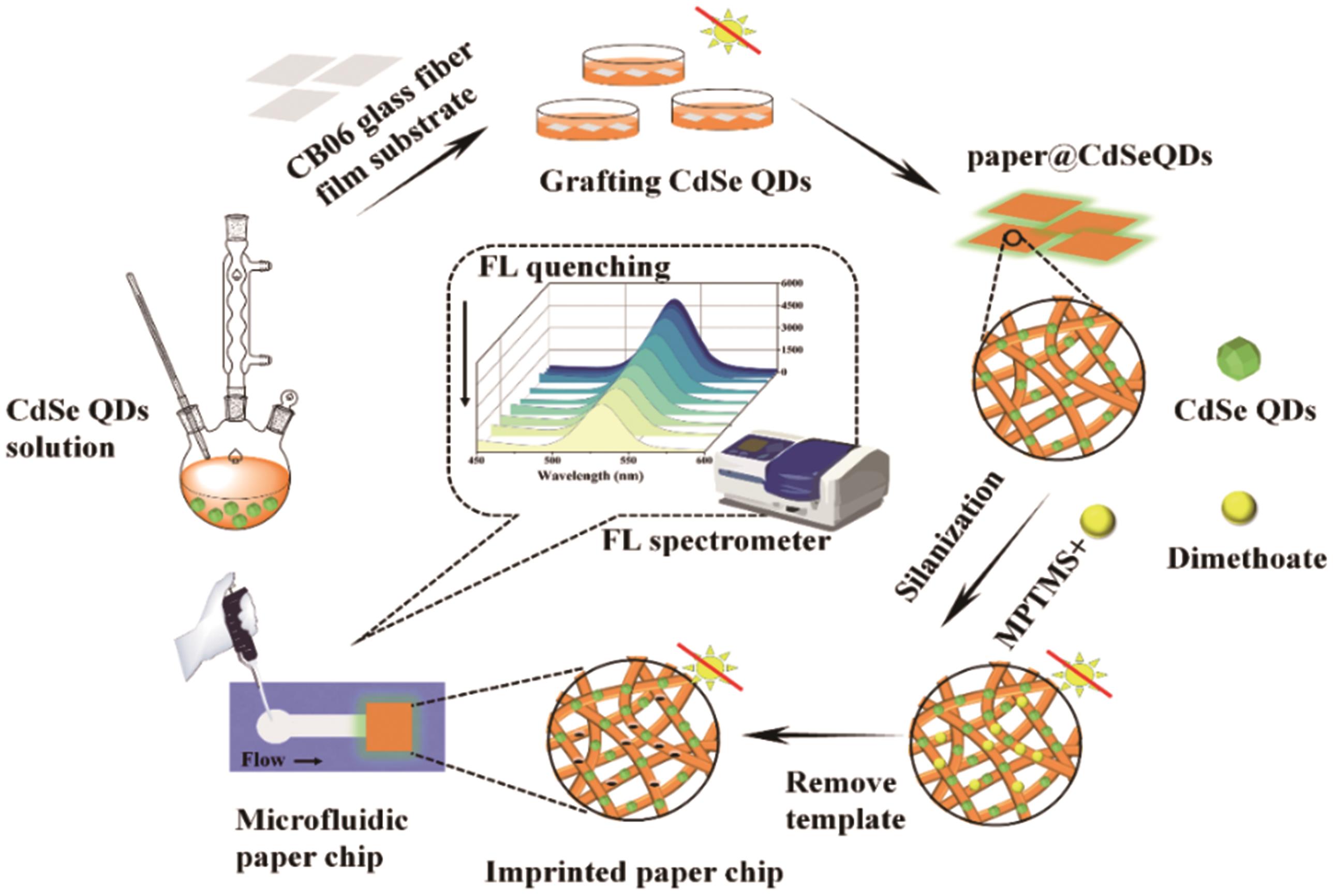
Chinese Journal of Applied Chemistry ›› 2024, Vol. 41 ›› Issue (4): 472-483.DOI: 10.19894/j.issn.1000-0518.230293
• Review • Previous Articles
Research Progress of Nanomaterial Sensors in the Detection of Organophosphorus Pesticide Residues
Kong-Hao PENG1, An-Qi BAI1, Ying MENG1, Hui YIN1, Xin-Yao SU1, Jin-Yu YANG1, Shu-Rong LI1,2, Ling-Yan ZHANG1,2, Li-Xia LUO1,2( ), Pei-Jun MENG1,2(
), Pei-Jun MENG1,2( )
)
- 1.School of Public Health,Baotou Medical College,Baotou 014040,China
2.Inner Mongolia Autonomous Region Health Testing and Evaluation Engineering Technology Center,Baotou 014040,China
-
Received:2023-09-25Accepted:2024-01-25Published:2024-04-01Online:2024-04-28 -
Contact:Li-Xia LUO,Pei-Jun MENG -
About author:mengpeijun79@163.com;
luoluo_80@yeah.net
-
Supported by:the National Natural Science Foundation of China(81960601);the Young Talents of Science and Technology in Universities of Inner Mongolia Autonomous Region(NJYT23026);the Provincial Natural Science Foundation of Inner Mongolia Autonomous Region(2023MS08009);the Medical and Health Technology Plan Project of Health Commission of Inner Mongolia Autonomous Region(202201383);the College Students' Innovative Entrepreneurial Training Plan Program of Inner Mongolia Autonomous Region in 2023(S202310130001)
CLC Number:
Cite this article
Kong-Hao PENG, An-Qi BAI, Ying MENG, Hui YIN, Xin-Yao SU, Jin-Yu YANG, Shu-Rong LI, Ling-Yan ZHANG, Li-Xia LUO, Pei-Jun MENG. Research Progress of Nanomaterial Sensors in the Detection of Organophosphorus Pesticide Residues[J]. Chinese Journal of Applied Chemistry, 2024, 41(4): 472-483.
share this article
Add to citation manager EndNote|Ris|BibTeX
URL: http://yyhx.ciac.jl.cn/EN/10.19894/j.issn.1000-0518.230293
| Nanomaterials matrix | Sensor type | Advantage | Disadvantage | The development trend |
|---|---|---|---|---|
| Rare earth doped upconversion nanomaterial | Fluorescence sensor | High sensitivity, good stability, simple sample pretreatment, real-time monitoring, with visualization | Need specific band light source irradiation excitation, detection scene is limited; The anti-interference ability of some fluorescence sensors needs to be enhanced | The nucleic acid aptamer, antigen and antibody with strong specificity were used to improve the specificity and anti-interference ability and realize the simultaneous detection of multiple residual targets |
| Metallic nanomaterial | Surface enhanced raman scattering sensor, colorimetric sensor, electrochemical sensor | High sensitivity, good stability, simple sample preparation, the sensitive electrochemical sensor is efficient, rapid detection | The anti-interference ability of some sensors needs to be enhanced, and the related sensors using the principle of enzyme inhibition can only detect the total amount of organophosphorus pesticides, and cannot achieve accurate detection of single residue | Using the characteristics of its own materials and other materials to construct a composite sensor, further improve the detection sensitivity, repeatability and anti-interference ability of the sensor |
| Metal oxide nanomaterial | Electrochemical sensor, surface enhanced raman scattering sensor, spectrophotometer sensor | Wide detection linear range, high sensitivity, high efficiency, low cost, can be used in the field of rapid detection, metal oxide properties, can be used in a variety of sensors | The anti-interference ability needs to be strengthened, the related sensors using the principle of enzyme inhibition cannot realize the simultaneous detection of multiple residues, and the repeatability needs to be improved | The composite sensor is constructed by using the characteristics of its own material and other materials, and the unique properties of the matrix material are fully utilized to optimize the performance of the sensor |
| Carbon nanomaterials | Electrochemical sensor, colorimetric sensors | High sensitivity, strong stability, portable, can realize the field rapid detection. | The related sensor based on the principle of enzyme inhibition can not realize the simultaneous detection of multiple residues, and the repeatability needs to be improved | The stability and modifiability of the material combined with other materials are utilized to further improve the sensor's specificity and multi-residue detection capability |
| Quantum dot nanomaterials | Photoelectric chemical sensor, Fluorescence sensor | High sensitivity, good stability, strong anti-interference ability | Some quantum dot composites are potentially toxic; Some sensors have poor specificity | Low-toxic or non-toxic quantum dots are used to build sensors and composite with other materials to improve sensor detection performance |
Table 1 Comparison of the advantages and disadvantages of organophosphorus pesticide sensors of different nanomaterials
| Nanomaterials matrix | Sensor type | Advantage | Disadvantage | The development trend |
|---|---|---|---|---|
| Rare earth doped upconversion nanomaterial | Fluorescence sensor | High sensitivity, good stability, simple sample pretreatment, real-time monitoring, with visualization | Need specific band light source irradiation excitation, detection scene is limited; The anti-interference ability of some fluorescence sensors needs to be enhanced | The nucleic acid aptamer, antigen and antibody with strong specificity were used to improve the specificity and anti-interference ability and realize the simultaneous detection of multiple residual targets |
| Metallic nanomaterial | Surface enhanced raman scattering sensor, colorimetric sensor, electrochemical sensor | High sensitivity, good stability, simple sample preparation, the sensitive electrochemical sensor is efficient, rapid detection | The anti-interference ability of some sensors needs to be enhanced, and the related sensors using the principle of enzyme inhibition can only detect the total amount of organophosphorus pesticides, and cannot achieve accurate detection of single residue | Using the characteristics of its own materials and other materials to construct a composite sensor, further improve the detection sensitivity, repeatability and anti-interference ability of the sensor |
| Metal oxide nanomaterial | Electrochemical sensor, surface enhanced raman scattering sensor, spectrophotometer sensor | Wide detection linear range, high sensitivity, high efficiency, low cost, can be used in the field of rapid detection, metal oxide properties, can be used in a variety of sensors | The anti-interference ability needs to be strengthened, the related sensors using the principle of enzyme inhibition cannot realize the simultaneous detection of multiple residues, and the repeatability needs to be improved | The composite sensor is constructed by using the characteristics of its own material and other materials, and the unique properties of the matrix material are fully utilized to optimize the performance of the sensor |
| Carbon nanomaterials | Electrochemical sensor, colorimetric sensors | High sensitivity, strong stability, portable, can realize the field rapid detection. | The related sensor based on the principle of enzyme inhibition can not realize the simultaneous detection of multiple residues, and the repeatability needs to be improved | The stability and modifiability of the material combined with other materials are utilized to further improve the sensor's specificity and multi-residue detection capability |
| Quantum dot nanomaterials | Photoelectric chemical sensor, Fluorescence sensor | High sensitivity, good stability, strong anti-interference ability | Some quantum dot composites are potentially toxic; Some sensors have poor specificity | Low-toxic or non-toxic quantum dots are used to build sensors and composite with other materials to improve sensor detection performance |
| 1 | WEI L, ZHU N, LIU X, et al. Application of Hi-throat/Hi-volume SPE technique in assessing organophosphorus pesticides and their degradation products in surface water from Tai Lake, east China[J]. J Environ Manage, 2022, 305: 114346. |
| 2 | MEDITHI S, KASA Y D, AJUMEERA R, et al. Effect of organophosphorus pesticide exposure on the immune cell phenotypes among farm women and their children[J]. Arch Environ Occup Health, 2022, 77(9): 702-710. |
| 3 | EDDLESTON M. Novel clinical toxicology and pharmacology of organophosphorus insecticide self-poisoning[J]. Annu Rev Pharmacol Toxicol, 2019, 59: 341-360. |
| 4 | ČADEŽ T, KOLIĆ D, ŠINKO G, et al. Assessment of four organophosphorus pesticides as inhibitors of human acetylcholinesterase and butyrylcholinesterase[J]. Sci Rep, 2021, 11(1): 21486. |
| 5 | YU G, LI Y, JIAN T, et al. Clinical analysis of acute organophosphorus pesticide poisoning and successful cardiopulmonary resuscitation: a case series[J]. Front Public Health, 2022, 10: 866376. |
| 6 | SOBOLEV V E, SOKOLOVA M O, JENKINS R O, et al. Molecular mechanisms of acute organophosphate nephrotoxicity[J]. Int J Mol Sci, 2022, 23(16): 8855. |
| 7 | TALAEE M, LORESTANI B, RAMEZANI M, et al. Microfunnel-filter-based emulsification microextraction followed by gas chromatography for simple determination of organophosphorus pesticides in environmental water samples[J]. J Sep Sci, 2019, 42(14): 2418-2425. |
| 8 | YANG Y, LI Y, HUANG Z, et al. Trace detection of organophosphorus pesticides in vegetables via enrichment by magnetic zirconia and temperature-assisted ambient micro-fabricated glow discharge plasma desorption ionization mass spectrometry[J]. Analyst, 2021, 146(22): 6944-6954. |
| 9 | 刘平, 王子怡, 赵旭东, 等. 通过式净化结合超高效液相色谱-串联质谱快速检测牛羊奶中有机磷农药残留[J]. 卫生研究, 2022, 51(3): 483-489. |
| LIU P, WANG Z Y, ZHAO X, et al. Determination of organophosphorus pesticide residues in milk of cows and sheep by ultra-high-performance liquid chromatography-tandem mass spectrometry combined with passing type purification method[J]. J Hygiene Res, 2022, 51(3): 483-489. | |
| 10 | LIU Z, XIA X, ZHOU G, et al. Acetylcholinesterase-catalyzed silver deposition for ultrasensitive electrochemical biosensing of organophosphorus pesticides[J]. Analyst, 2020, 145(6): 2339-2344. |
| 11 | WU H L, WANG B Z, WANG Y, et al. Monoclonal antibody-based icELISA for the screening of diazinon in vegetable samples[J]. Anal Methods, 2021, 13(16): 1911-1918. |
| 12 | BADAWY S M. Optimization of reaction time for detection of organophosphorus pesticides by enzymatic inhibition assay and mathematical modeling of enzyme inhibition[J]. J Environ Sci Health B, 2021, 56(2): 142-149. |
| 13 | FAROKHZAD OC, LANGER R. Impact of nanotechnology on drug delivery[J]. ACS Nano, 2009, 3(1): 16-20. |
| 14 | LI H H, ALI S, WEI W Y, et al. Rapid detection of organophosphorus in tea using NaY/GdF4∶Yb,Er-based fluorescence sensor[J]. Microchem J, 2020, 159: 105462. |
| 15 | WANG P, LI H, HASSAN M M, et al. Fabricating an acetylcholinesterase modulated UCNPs-Cu2+ fluorescence biosensor for ultrasensitive detection of organophosphorus pesticides-diazinon in food[J]. J Agric Food Chem, 2019, 67(14): 4071-4079. |
| 16 | MU X Q, WANG D, MENG L Y, et al. Glutathione-modified graphene quantum dots as fluorescent probes for detecting organophosphorus pesticide residues in radix angelica sinensis[J]. Spectrochim Acta A Mol Biomol Spectrosc, 2023, 286: 122021. |
| 17 | CHANG H W, CHEN C L, CHEN Y H, et al. Electrochemical organophosphorus pesticide detection using nanostructured gold-modified electrodes[J]. Sensors, 2022, 22(24): 9938. |
| 18 | SONG D, JIANG X, LI Y, et al. Metal-organic frameworks-derived MnO2/Mn3O4 microcuboids with hierarchically ordered nanosheets and Ti3C2 MXene/Au NPs composites for electrochemical pesticide detection[J]. J Hazard Mater, 2019, 373: 367-376. |
| 19 | PORTO L S, FERREIRA L F, PIO DOS SANTOS W T, et al. Determination of organophosphorus compounds in water and food samples using a non-enzymatic electrochemical sensor based on silver nanoparticles and carbon nanotubes nanocomposite coupled with batch injection analysis[J]. Talanta, 2022, 246: 123477. |
| 20 | 程娇娇, 彭微, 孟颖, 等. Yb3+/Er3+双掺杂的NaYF4上转换纳米功能材料的制备与设计优化[J].分析科学学报, 2022, 38(4): 448-454. |
| CHENG J J, PENG W, MENG Y, et al. Preparation and optimization of Yb3+/Er3+ double-doped NaYF4 upconversion nanofunctional materials[J]. J Amal Sci, 2022, 38(4): 448-454. | |
| 21 | 李明. NaYF4∶Yb,Tm上转换发光纳米材料的合成及在手印显现中的应用研究[J]. 化学研究与应用, 2021, 33(9): 1770-1775. |
| LI M. Synthesis of NaYF4∶Yb,Tm upconversion luminescent nanomaterials and their applications in fingerprint development[J]. Chem Res Appl, 2021, 33(9): 1770-1775. | |
| 22 | GE J, CHEN L, HUANG B, et al. Anchoring group-mediated radiolabeling of inorganic nanoparticles-a universal method for constructing nuclear medicine imaging nanoprobes[J]. ACS Appl Mater Interfaces, 2022, 14(7): 8838-8846. |
| 23 | LIANG Z, WANG X, ZHU W, et al. Upconversion nanocrystals mediated lateral-flow nanoplatform for in vitro detection[J]. ACS Appl Mater Interfaces, 2017, 9(4): 3497-3504. |
| 24 | ZOU R, CHANG Y, ZHANG T, et al. Up-converting nanoparticle-based immunochromatographic strip for multi-residue detection of three organophosphorus pesticides in food[J]. Front Chem, 2019, 7: 18. |
| 25 | LIU M, WEI J, WANG Y, et al. Dopamine-functionalized upconversion nanoparticles as fluorescent sensors for organophosphorus pesticide analysis[J]. Talanta, 2019, 195: 706-712. |
| 26 | RONG Y, LI H, OUYANG Q, et al. Rapid and sensitive detection of diazinon in food based on the FRET between rare-earth doped upconversion nanoparticles and graphene oxide[J]. Spectrochim Acta A Mol Biomol Spectrosc, 2020, 239: 118500. |
| 27 | 向发椿. NaYF4基上转换纳米材料的制备及在有机磷检测中的应用研究[D]. 成都: 成都理工大学, 2021. |
| XIANG F C. Preparation of based-NaYF4 upconversion nanomaterials and application in the detection of organophosphorus[D]. Chengdu: Chengdu University of Technology, 2021. | |
| 28 | CHEN Y, XIANYU Y, JIANG X. Surface modification of gold nanoparticles with small molecules for biochemical analysis[J]. Acc Chem Res, 2017, 50(2): 310-319. |
| 29 | RIAZ M, ALTAF M, FAISAL A, et al. Biogenic synthesis of AgNPs with Saussurea lappa C.B. clarke and studies on their biochemical properties[J]. J Nanosci Nanotechnol, 2018, 18(12): 8392-8398. |
| 30 | YASEEN T, PU H, SUN D W. Rapid detection of multiple organophosphorus pesticides (triazophos and parathion-methyl) residues in peach by SERS based on core-shell bimetallic Au@Ag NPs[J]. Food Addit Contam Part A Chem Anal Control Expo Risk Assess, 2019, 36(5): 762-778. |
| 31 | HOU L, ZHANG X, KONG M, et al. A competitive immunoassay for electrochemical impedimetric determination of chlorpyrifos using a nanogold-modified glassy carbon electrode based on enzymatic biocatalytic precipitation[J]. Mikrochim Acta, 2020, 187(4): 204. |
| 32 | LIU D L, LI Y, SUN R, et al. Colorimetric detection of organophosphorus pesticides based on the broad-spectrum aptamer[J]. J Nanosci Nanotechnol, 2020, 20(4): 2114-2121. |
| 33 | YANG H, SUN Z, QIN X, et al. Ultrasmall Au nanoparticles modified 2D metalloporphyrinic metal-organic framework nanosheets with high peroxidase-like activity for colorimetric detection of organophosphorus pesticides[J]. Food Chem, 2021, 376: 131906. |
| 34 | YANG F, LI J, DONG H, et al. A novel label-free electrochemiluminescence aptasensor using a tetrahedral DNA nanostructure as a scaffold for ultrasensitive detection of organophosphorus pesticides in a luminol-H2O2 system[J]. Analyst, 2022, 147(4): 712-721. |
| 35 | YAN X, SONG Y, ZHU C, et al. MnO2 nanosheet-carbon dots sensing platform for sensitive detection of organophosphorus pesticides[J]. Anal Chem, 2018, 90(4): 2618-2624. |
| 36 | XIE Y, TU X, MA X, et al. A CuO-CeO2 composite prepared by calcination of a bimetallic metal-organic framework for use in an enzyme-free electrochemical inhibition assay for malathion[J]. Mikrochim Acta, 2019, 186(8): 567. |
| 37 | LIN Z, ZHANG S, HUANG Z, et al. Spectrophotometric detection of fenthion in foods after extraction by magnetic zirconia[J]. Appl Opt, 2020, 59(10): 3043-3048. |
| 38 | QIN Y, WU Y, CHEN G, et al. Dissociable photoelectrode materials boost ultrasensitive photoelectrochemical detection of organophosphorus pesticides[J]. Anal Chim Acta, 2020, 1130: 100-106. |
| 39 | SUN Y, WEI J, ZOU J, et al. Electrochemical detection of methyl-paraoxon based on bifunctional cerium oxide nanozyme with catalytic activity and signal amplification effect[J]. J Pharm Anal, 2021, 11(5): 653-660. |
| 40 | LV M, PU H, SUN D W. Preparation of Fe3O4@UiO-66(Zr)@Ag NPs core-shell-satellite structured SERS substrate for trace detection of organophosphorus pesticides residues[J]. Spectrochim Acta A Mol Biomol Spectrosc, 2023, 294: 122548. |
| 41 | YAO T, TIAN Z, ZHANG Y, et al. Phosphatase-like activity of porous nanorods of CeO2 for the highly stabilized dephosphorylation under interferences[J]. ACS Appl Mater Interfaces, 2019, 11(1): 195-201. |
| 42 | ZHAO H, LI B, LIU R, et al. Ultrasonic-assisted preparation of halloysite nanotubes/zirconia/carbon black nanocomposite for the highly sensitive determination of methyl parathion[J]. Mater Sci Eng C Mater Biol Appl, 2021, 123: 111982. |
| 43 | MOCCI F, DE VILLIERS ENGELBRECHT L, OLLA C, et al. Carbon nanodots from an in silico perspective[J]. Chem Rev, 2022, 122(16): 13709-13799. |
| 44 | YU G, WU W, ZHAO Q, et al. Efficient immobilization of acetylcholinesterase onto amino functionalized carbon nanotubes for the fabrication of high sensitive organophosphorus pesticides biosensors[J]. Biosens Bioelectron, 2015, 68: 288-294. |
| 45 | CHU S, HUANG W, SHEN F, et al. Graphene oxide-based colorimetric detection of organophosphorus pesticides via a multi-enzyme cascade reaction[J]. Nanoscale, 2020, 12(10): 5829-5833. |
| 46 | WEN L, WANG J, LIU Z, et al. A portable acetylcholinesterase-based electrochemical sensor for field detection of organophosphorus[J]. RSC Adv, 2023, 13(10): 6389-6395. |
| 47 | 程娇娇, 彭微, 靳敏, 等. 量子点在卫生分析领域中的应用[J]. 化学通报, 2022, 85(3): 341-350. |
| CHENG J J, PENG W, JIN M,et al. Application of quantum dots in the field of health analysis[J]. Chemistry, 2022, 85(3): 341-350. | |
| 48 | MARTINS C S M, LAGROW A P, PRIOR J A V. Quantum dots for cancer-related miRNA monitoring[J]. ACS Sens, 2022, 7(5): 1269-1299. |
| 49 | JIA M, JIA B, LIAO X, et al. A CdSe@CdS quantum dots based electrochemiluminescence aptasensor for sensitive detection of ochratoxin A[J]. Chemosphere, 2022, 287(Pt 1): 131994. |
| 50 | LI X, ZHENG Z, LIU X, et al. Nanostructured photoelectrochemical biosensor for highly sensitive detection of organophosphorous pesticides[J]. Biosens Bioelectron, 2015, 64: 1-5. |
| 51 | HU T, XU J, YE Y, et al. Visual detection of mixed organophosphorous pesticide using QD-AChE aerogel based microfluidic arrays sensor[J]. Biosens Bioelectron, 2019, 136: 112-117. |
| 52 | KORRAM J, DEWANGAN L, KARBHAL I, et al. CdTe QD-based inhibition and reactivation assay of acetylcholinesterase for the detection of organophosphorus pesticides[J]. RSC Adv, 2020, 10(41): 24190-24202. |
| 53 | YAN X, ZHANG Z, ZHANG R, et al. Rapid detection of dimethoate in soybean samples by microfluidic paper chips based on oil-soluble CdSe quantum dots[J]. Foods, 2021, 10(11): 2810. |
| 54 | LIU F, LEI T, ZHANG Y, et al. A BCNO QDs-MnO2 nanosheets based fluorescence “off-on-off” and colorimetric sensor with smartphone detector for the detection of organophosphorus pesticides[J]. Anal Chim Acta, 2021, 1184: 339026. |
| 55 | FAN M, GAN T, YIN G, et al. Molecularly imprinted polymer coated Mn-doped ZnS quantum dots embedded in a metal-organic framework as a probe for selective room temperature phosphorescence detection of chlorpyrifos[J]. RSC Adv, 2021, 11(45): 27845-27854. |
| [1] | Jia-Huan PEI, Xiao-Hua QI, Ming-Qiang ZOU, Yong JIN, De-Ying WANG, Yun-Jing LUO. Advances in Surface-Enhanced Raman Spectroscopy for the Detection of Veterinary Drug Residues in Foods of Animal Origin [J]. Chinese Journal of Applied Chemistry, 2024, 41(4): 459-471. |
| [2] | Hui-Hui LI, Kai-Sheng YAO, Ya-Nan ZHAO, Li-Na FAN, Yu-Lin TIAN, Wei-Wei LU. Ionic Liquid-Modulated Synthesis of Pt-Pd Bimetallic Nanomaterials and Their Catalytic Performance for Ammonia Borane Hydrolysis to Generate Hydrogen [J]. Chinese Journal of Applied Chemistry, 2023, 40(4): 597-609. |
| [3] | Xiao-Hu LIU, Xiao-Juan LAI, Hong-Yan CAO, Ting-Ting WANG, Zhi-Qiang DANG. Synergistic Performance of Foaming Agent/Stabilizer/SiO2 Composite Foam Retarded Acid System [J]. Chinese Journal of Applied Chemistry, 2023, 40(1): 91-99. |
| [4] | Hui DU, Chen-Yang YAO, Hao PENG, Bo JIANG, Shun-Xiang LI, Jun-Lie YAO, Fang ZHENG, Fang YANG, Ai-Guo WU. Applications of Transition Metal⁃doped Iron⁃based Nanoparticles in Biomedicine [J]. Chinese Journal of Applied Chemistry, 2022, 39(3): 391-406. |
| [5] | Xiao-Mei HUANG, Xiang DENG, Lang-Man XING, Wei CHEN, Li SUN, Xiao-Yu ZHU. Study of Electrochemical Non-enzyme Glucose Sensor Based on Cu(Ⅱ)Co(Ⅱ) Bimetallic Carbon Nanosheets [J]. Chinese Journal of Applied Chemistry, 2022, 39(12): 1891-1902. |
| [6] | HUANG Xiao-Tong, CHEN Ying-Xin, ZHU Ze-Bin, ZHOU Li-Hua. Research Progress on Detection of Ascorbic Acid by Nanomaterial-Based Spectral Analysis Method [J]. Chinese Journal of Applied Chemistry, 2021, 38(6): 637-650. |
| [7] | LIU Jiao, ZOU Peng-Fei, LI Ping, ZHANG Xiao, WANG Xin-Xin, GAO Yuan-Yuan, LI Li-Li. Research Progress of the Peptide-Based Self-assembled Nanomaterials Against Microbial Resistance [J]. Chinese Journal of Applied Chemistry, 2021, 38(5): 546-558. |
| [8] | YOU Wei, ZHAO Ya-Bin, SUN Jing, LI Wen-Jie, WANG Li-Xue. Recent Progress in Donor Profiling Through Fingermark Residue Analysis [J]. Chinese Journal of Applied Chemistry, 2021, 38(4): 376-389. |
| [9] | WANG Cong, ZHAO Xiao-Yu, WANG Hai-Yan, CAO Jin, WANG Gang-Li. Detection of 73 Veterinary Drugs Residues in Animal Muscle Tissues by High Performance Liquid Chromatography-Triple Quadrupole Mass Spectrometry [J]. Chinese Journal of Applied Chemistry, 2021, 38(12): 1663-1675. |
| [10] | LIU Lin-Chang, GUO Ya-Jun, ZHU Hong-Lin, MA Jing-Jing, LI Zhong-Yi, SHUI Miao, ZHENG Yue-Qing. Research Progress on Supported Ultrafine Nano-catalysts for Hydrolytic Dehydrogenation of Ammonia Borane [J]. Chinese Journal of Applied Chemistry, 2021, 38(11): 1405-1422. |
| [11] | MENG Yang, YANG Chan, PENG Juan. Progress in Iron, Cobalt and Nickel-Based Metal Phosphide Nano-catalysts for Hydrogen Production under Alkaline Conditions [J]. Chinese Journal of Applied Chemistry, 2020, 37(7): 733-745. |
| [12] | FAN Zhe,ZHANG Shengsheng,TANG Jiahao,FAN Ping. Structure, Preparation and Application of Graded Nanomaterials [J]. Chinese Journal of Applied Chemistry, 2020, 37(5): 489-501. |
| [13] | WANG Chunli,SUN Lianshan,ZHONG Ming,WANG Limin,CHENG Yong. Research Progress of Transition Metal and Compounds for Lithium-Sulfur Batteries [J]. Chinese Journal of Applied Chemistry, 2020, 37(4): 387-404. |
| [14] | WANG Qiushi, HE Junhui. Synthesis of Magnetic CuS Composite Nanomaterial and Its Specific Adsorption of Hg(II) in Water [J]. Chinese Journal of Applied Chemistry, 2020, 37(11): 1316-1323. |
| [15] | LIU Zhirong. Evaluation on Efficiencies of 11 Purification Methods Toward 50 Pesticide Residues in Angelica sinensis by Ultra-high Performance Liquid Chromatography/Tandem Mass Spectrometry [J]. Chinese Journal of Applied Chemistry, 2019, 36(8): 968-976. |
| Viewed | ||||||
|
Full text |
|
|||||
|
Abstract |
|
|||||
